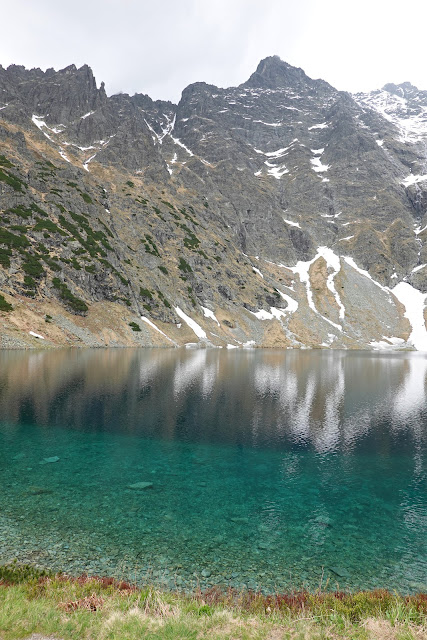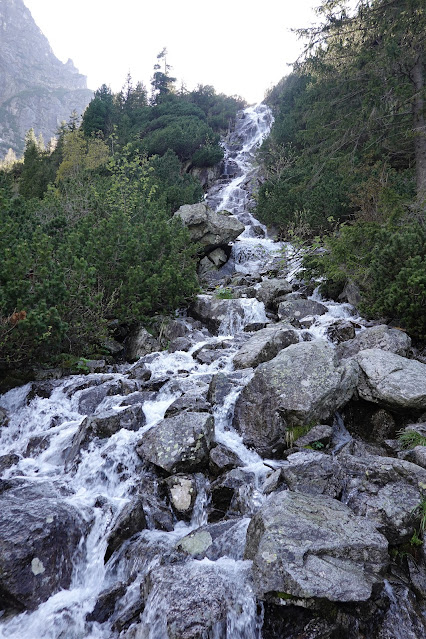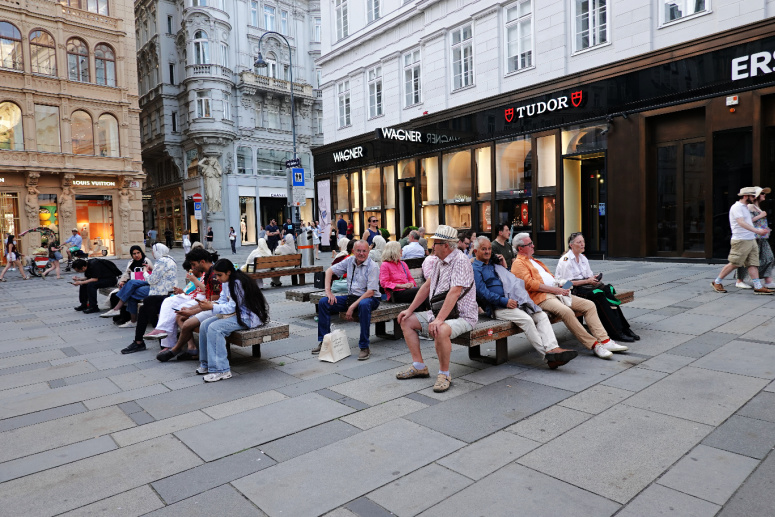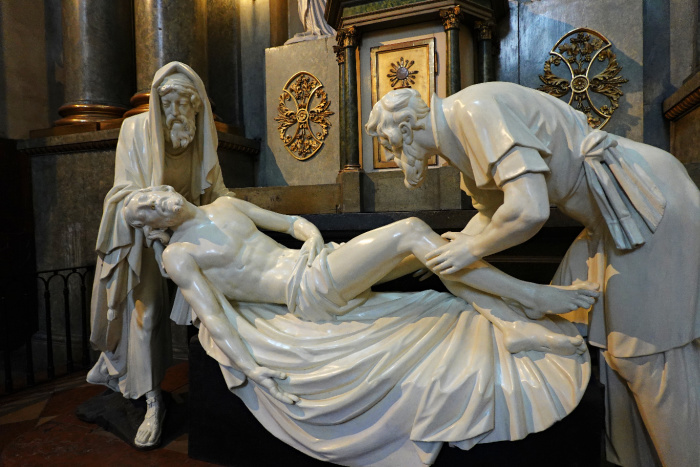I've been looking forward to this excursion for years now, and today was finally the day it would happen. Would it go as planned, or would weather or something else put a damper on our day?We took a shuttle from Zakopane to Palenica Białczańska, the starting point for our jaunt into the High Tatra Mountains of Poland. Our destination, Morskie Oko, was five miles away, and there were only two ways to get there: on foot, or by horse-drawn wagon. We chose the latter.
Of course, we had to pay a steep fee for that option⸺200 złoty⸺but Jenelle's back still hurt from her surgery and we didn't want her worn out by having to walk up the mountain.
The path to the lake is paved and the vast majority of people walk it. And there are thousands of them! Young, old, partially crippled, mothers with strollers. It's like a long line of ants on a 5.6 mile path.
We, on the other hand, waited for over an hour for our turn to ride the horses. We weren't going to ride the horses directly, but were to sit in a covered wagon pulled by two horses. The problem was that only so many people could ride in a wagon at once.
When a team of horses completed the circuit, we would have to wait for them to take a break, drink, eat, and get pampered by their owners. This was quite a tiresome job for them, and they couldn't continue the loop without a rest. Although there were many teams on duty for work, it was a slow process to rotate through them.
 |
| Riding in a horse-drawn wagon to Morskie Oko. |
Our driver of the wagon dressed in traditional Polish attire, with a brown leather hat and gray sweater. As we moved up the road, the horses' hooves clacked on the pavement. Their tails swooped back and forth, and the fresh scent of manure mixed with cold mountain air.
We passed two brown does feeding off the road, then small rivulets of water coming down the green slopes. As we got higher we passed a much larger waterfall.
 |
| Waterfall along the way. |
I felt sorry for the horses. Their job was to pull a wagon full of people up a tediously inclining road, and sometimes at a trot. When we passed other teams coming down, I saw sweat on their flanks.
As we got higher on our route, views of the craggy peaks of the Tatras became more splendid. Streaks of snow in the gulleys of the upper slopes still lingered from winter.
At last, after a 3.8 mile ride, our adventure on the horses came to an end and it was now up to us to walk the remaining mile or so up to the lake. In true European fashion, an ice cream shack and restaurant stood beside the road to serve us. Not now. Maybe on the way back.
 |
| Morskie Oko. |
When we arrived at the lake, the view was just as spectacular as I had anticipated: a beautiful deep-blue pool of water surrounded by majestic mountains. Hundreds of people loitered about the edges of the lake admiring the view and taking selfies. Near the shore was a large wooden “hut” where hungry hikers could buy a sandwich and beer.
After a few quick pictures we moved around to the eastern edge of the lake. A trail made with relatively flat mountain rocks made a circuit completely around the lake. We enjoyed the view as we hiked. A handful of waterfalls tumbled into the lake from random points, most likely from melting snow and springs.
 |
| Swiss pines grow along east side of Morskie Oko. |
Morskie Oko, the name of this beautiful lake, comes from Polish meaning “eye of the sea.” It has been recognized as one of the most beautiful lakes in the world.
It's about half a mile to the back side of the lake, and it is from here that another trail climbs nearly 600 feet to another lake. This one is named Czarny Staw pod Rysami, or "Black Lake Below Mount Rysy" when translated into English. By this time, Jenelle was doing better than expected, so we decided to make it a go to the upper lake.
 |
| Sign on south side of Morskie Oko. |
 |
| Looking down at Morskie Oko from the trail going up to Czarny Staw. |
 |
| Cascading stream coming down from Czarny Staw. |
The trail was steep and tedious, but was made bearable by elevated views of Morskie Oko, as well as a cascading stream that tumbled down alongside the trail. I was proud of Jenelle. She was doing much better than either of us expected.
Half an hour later we arrived at the second lake, and what a wonderful view it was! Not only did we have the grand view of Morskie Oko, but now the full view of Czarny Staw. Unlike the lower lake, this one was more transparent and had a turquoise ring around it when the sun was out. The center, however, was a dark blue, probably the reason for the lake's name. At 249 feet, it is the fourth deepest lake in Poland. Mount Rysy, the highest peak in Poland, reigns supreme above it.
 |
| Czarny Staw pod Rysami, or "Black Lake Below Mount Rysy" in English. |
 |
| Mount Rysy, above Czarny Staw, is the highest peak in Poland. |
 |
| Hikers enjoy the shore of Czarny Staw. |
The craggy ridgeline on either side of Rysy serves as the boundary between Poland and Slovakia. If circumstances were different, meaning I were here alone and it was later in the summer, I would have hiked Rysy. Apparently hundreds do it every day during the latter part of the summer. It is a steep ascent, but there are cables to assist the climber.
We spent nearly forty five minutes at Czarny Staw. It was enjoyable to watch the groups of hikers as they lounged around and rested. I was very pleasantly surprised that it hadn't rained. Juicy storm clouds threatened, but with no success. I was worried that by this time we would have been deploying umbrellas and fighting slippery rocks.
 |
| Natural platform between Morskie Oko and Czarny Staw. |
The way down was much easier than the trip up. We decided to complete the circuit and take the west side of Morskie Oko. We didn't take nearly as many pictures, so it went a lot faster.
Hiking on the west side gave us new views of the lake and mountains. We enjoyed walking across the base of one of the waterfalls. There I refilled my water bottle.
 |
| Looking across the lake at "the hut." |
 |
| Waterfall tumbling into Morskie Oko. |
 |
| Looking back across Morskie Oko toward Czarny Staw (not seen) and Mount Rysy. |
 |
| Looking northeast across Morskie Oko. |
When we completed our hike around the lake and again returned to the hut, we had accumulated 3.7 miles. Jenelle was still doing great. Adrenaline must have been kicking in.
Our plan was to hike down instead of taking the horse and wagon. I was excited for this. It was an opportunity to see the mountainside at a slower pace.
We stopped at the lower hut and ordered an ice cream and pannini. It really hit the spot! We sat at a table and watched the hikers on the road.
 |
| Eating a snack at a hut about a mile down from the lake. |
Then we continued. We took note of the thick, fairy-like forest with moss growing on the logs. Jenelle noticed the thousands upon thousands of scrape marks in the pavement where horses' hooves clanked across the top.
From time to time we would hear the clapping on the pavement behind us, then would turn around and watch a team and wagon come along full of people. One wagon was singing a song as they passed.
 |
| Beautiful forest in the High Tatra Mountains. |
I was most impressed with the sheer amount of people walking the trail, especially families with young kids. One set of parents hauled up little scooters, then once at the top, let their two little girls⸺no older than four years old⸺ride them down. Several parents pushed strollers. It was a level of commitment that I have rarely seen in the States.
Five point four miles later we had made it to the bottom! Our total for the day was 9.1 miles. Luckily for us there was a line of shuttles waiting at the bottom to take us back to Zakopane. ♠
























































